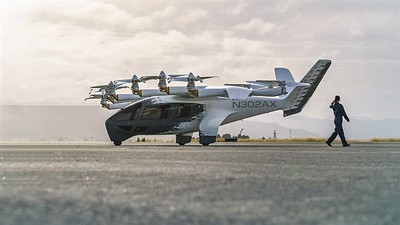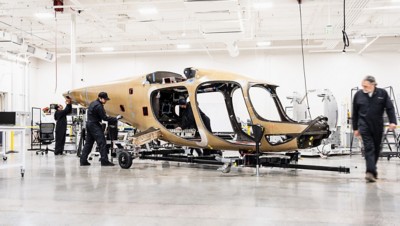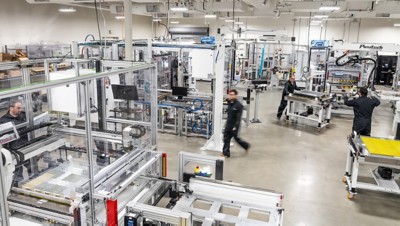NI Accelerates Archer Aviation Midnight™
Tramone Curry, PhD, Director of Integrated Test, Archer Aviation Inc.
https://archer.com/
"At Archer, we set ambitious goals, make data-driven decisions, hold ourselves and each other accountable, and are committed to relentless execution. It was important to us to have a partner that aligns with our priorities and that shares the common value of engineering ambitiously."
- Tramone Curry, PhD, Director of Integrated Test, Archer Aviation Inc.
The Challenge
Archer strives to deploy 3,000 aircraft by 2030. To achieve the capability, safety, and scale required ahead of their competition, they will have to test the technologies and designs used in the Midnight™ aircraft on a more accelerated timeline than traditional airframe development. The integrated test team at Archer will have to build solutions to support aircraft development as well as simulation environments.
The Solution
The Archer integrated test team has currently delivered mechanical test rigs, six HIL test benches, and three integrated test labs based largely on the NI Line Replaceable Unit (LRU) Test System Reference Architecture. The first NI-based systems were operational within three months, allowing the team to meet all the early test milestones for the program at a reduced cost of about 30 percent relative to competitive solutions.
Building a Simulation Platform for eVTOL Integrated Test Labs
Purpose
The team at Archer is innovating in key areas of the technologies that enable the commercialization of electric vertical takeoff and landing (eVTOL) aircraft. We’re building a proprietary electric powertrain system that maintains a long service life wis significantly more power dense and higher efficiency than what is in the market today—while maintaining a long service life. The powertrain system will be powered by existing mass production cells that are designed with the highest safety standards in mind at both the cell and pack level.
Meeting all those design specifications requires our integrated test team to deliver solutions that provide the aircraft development teams with all the insights they need to quickly iterate on—and improve—aircraft system hardware and software. Additionally, the test solution must provide simulation environments for aircraft systems equivalent to real aircraft interfaces to be tested against and support multiple stages of testing from the individual system level to the fully integrated aircraft level.
It is always ideal that the final test solution achieves all the test requirements while also having lower capital and operational costs than the alternatives. The one thing that no test team in aerospace can sacrifice is maximum assurance of reliability and safety for the aircraft pilots and passengers.
Overall Requirements and Constraints
Each control system and its components are being designed and built by teams in multiple labs. Those teams set test parameters and performance expectations that need to be validated by the integrated test team. As such, each individual component and subsystem must be able to be simulated and tested on its own as well as part of the integrated aircraft.
In our case, a few of the individual component testers had been created already, and some of the fixtures and cables were also already built into the facility and had to work with the solution we chose. But the test solution for the fully integrated aircraft had to be designed, built, and deployed on a set timeline to meet our development milestones.
The largest constraint we faced for delivering these systems was the number of human-hours needed to design, build, and deploy the solution compared to what we had available.
Simulation Requirements
The test systems had to meet all these requirements:
- Integrate aircraft system models as well as environmental models used to simulate flight conditions.
- Monitor the electrical signals and communication buses throughout the aircraft.
- Inject faults into the individual systems and fully integrated aircraft to simulate failures, shorts, and more.
- Support switching between real LRUs and subsystems in the loop as well as emulated LRUs and subsystems.
Simulation Hardware Platform Selection
A few key factors weighed into our decision for the proper test hardware for our solution:
- Shorten lead times
- Reduce cost
- Familiarity
- Platform architecture
The eVTOL industry is new and growing, and we face many challenges as a start-up in that new category. We don’t have the luxury of time and financial resources that some other established aviation companies may have. One of the reasons we chose NI was that they helped us maximize our resources by letting us acquire hardware at much lower lead times than other suppliers and at relatively lower costs through volume discounts. The NI solution was roughly 30 percent lower capital cost in comparison to the best alternative. Additionally, our familiarity with NI’s tools helped us feel more comfortable with this choice—and allowed us to customize the system for our needs more efficiently.
The NI SLSC platform fit our requirements because much like PXI, it allowed us to utilize a variety of modules to integrate and commission systems sooner, while maintaining the customizability we need. We used SLSC modules to accomplish routing and faulting, digital (discrete) output simulation, real/simulated switching, and variable differential transformer (VDT) emulation. The breakout panels available for NI LRU Test Systems were an important component in our systems as well. They allowed us to monitor, simulate, and interface to any subsystem of interest as well as insert fault signals that the system was otherwise incapable of producing. Additionally, we used the breakout panels to conduct self-calibration of system components.
Software and Distributed Simulation Architecture
Our objectives with simulation and test system software were to achieve the following goals:
- Monitor signals between LRUs
- Inject failure signals to LRUs
- Partially or fully simulate aircraft LRUs
- Acquire data through instrumentation
There is a high standard when it comes to passing an aircraft for flight, and our test objectives reflected that. Beyond the equipment, NI provided the technical support necessary to help us accomplish our objectives. We could call on them for a range of technical expertise from low to high level; one example included questions about the software drivers to input on the user interface, and they delivered.
For the distributed simulation architecture, we used The MathWorks, Inc. Simulink® software to generate custom models and NI VeriStand™ to integrate those models and accelerate the embedded software testing. VeriStand provided a user interface to simplify I/O channel configuration, data logging, and stimuli generation, and with it we were able to automate datalogging and test sequences. Once we imported the custom device models from Simulink to VeriStand, we were able to do real-time execution of system simulations, closed-loop controllers, and signal analysis algorithms.
Using the VeriStand engine, we were able to execute test sequences on our custom models, for the different conditions, by running NI LabVIEW code. The VeriStand engine is designed to be real-time, which means it runs independently from the user interface to ensure the determinism of the system. When an aircraft is in flight, every second in the air counts, which is why determinism is so important to us. The timing of the in-flight operating systems must be guaranteed with a certain margin of error that we can always anticipate for maximum reliability.
Flying the plane through a simulated environment required a sophisticated data-sharing framework and time synchronization across the aircraft and test systems to make it as close to the real environment as possible. We used IRIG-B time synchronization protocol to achieve the tight timing needed as well as RDMA hardware with the data sharing framework and RDMA plugin provided by NI to share data in real time across the system.
Outcomes and Results
With the help of NI technology and the expertise of NI people, we successfully built three fully integrated labs, six HIL benches, and multiple mechanical test rigs. We also delivered operational test articles within a three-month timeframe and achieved all the early milestone goals set in the program. At Archer, we set ambitious goals, make data-driven decisions, hold ourselves and each other accountable, and are committed to relentless execution. It was important to us to have a partner that aligns with our priorities and that shares the common value of engineering ambitiously. The modular approach we took, which was based on the LRU Test System Reference Architecture, enabled us to be more agile with the testing of our aircraft systems. NI’s modular test systems and the flexibility of their software enables our engineers to continue integration and maturation of their systems, as requirements inevitably change.
Simulink® is a registered trademark of The MathWorks, Inc.



